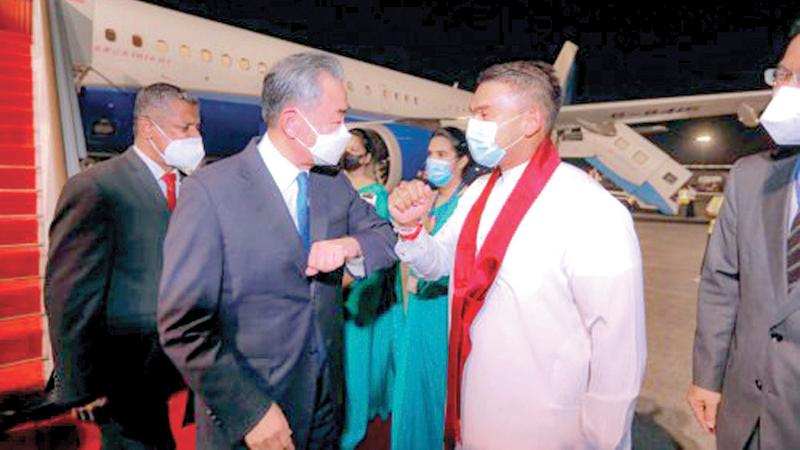
Sri Lanka’s economy is in recovery mode from the pandemic shock but faces a growing foreign debt problem. Sri Lanka requested China to restructure its debt during the recent visit by Foreign Minister Wang Yi.
China, however, faces the difficult dilemma of deciding if it should do so. Sri Lanka should take urgent steps to implement measures to tackle the economic crisis, which China can usefully support through multilateral institutions such as the International Monetary Fund and the World Bank.
Chinese Foreign Minister Wang Yi visited Sri Lanka on January 9 and 10 to mark the 65th anniversary of diplomatic relations between the two countries. The high-level visit came at a time of economic uncertainties with Sri Lanka in the throes of an economic crisis and China facing a slowing economy.
A rapidly spreading Omicron virus poses additional challenges. Several issues are being debated in policy and diplomatic circles in Sri Lanka following the minister’s visit: What is the state of Sri Lanka economy? Will China increase its assistance? What are Sri Lanka’s policy choices?
Even before the pandemic, the economy was experiencing macroeconomic stress – as indicated by slowing growth, large fiscal and balance of payments deficits and high external debt. The pandemic and the containment measures tipped the economy over the edge with growth slipping to -3.6 per cent in 2020. Despite this toll, signs of an economic recovery during the first nine months of 2021 point to possible growth of three-four per cent in 2021.
Dark clouds
However, dark clouds of risk hover over the economy in 2022, including a spreading Omicron virus, a worsening external debt position, rising inflation, social tensions and waning business confidence.
The pandemic-led economic crisis has set back Sri Lanka’s enviable social progress with at least an additional half-a-million people becoming the ‘new poor’. Women have felt heightened pressures during this period, causing some to leave the workforce. They seem more at risk of losing their jobs than men, resulting in rising female unemployment rates.
The pandemic has also significantly worsened Sri Lanka’s debt problem. Public expenditure fell during 2020-2021 as the government scrambled to put in place measures to mitigate the reduction in economic activities while revenue generation fell to historic lows due to the economic contraction, job losses and previous income tax cuts. The fiscal deficit has steeply risen. The country’s unfavourable debt dynamics reflects persistent fiscal and current account deficits: notable currency depreciation, the cost of 30 years of terrorism, lacklustre post-terrorism growth and a graduation from grant aid to foreign commercial borrowing.
Increasing concerns about debt-servicing capability have led to international credit ratings agencies downgrading Sri Lanka’s ratings, shutting off access to international bond markets, foreign capital outflows and pressures on the currency. Sri Lanka’s external debt reached US$49.2 billion (S$66.7 billion) in December 2020, with substantial debt repayments of US$4-5 billion (S$5.4-6.8 billion) a year required between 2022 and 2026, backed by dangerously low foreign exchange reserves.
‘Debt trap’
China and Sri Lanka have enjoyed warm diplomatic ties since Sri Lanka first recognised China in 1950. China’s global ascent has moved its diplomatic relations with Sri Lanka in a more commercial direction. Since the early 2000s, China has become a leading provider of commercial loans to Sri Lanka for infrastructure projects, including the Hambantota Port.
There are claims that by accepting such loans, Sri Lanka is now stuck in a ‘debt trap’. But Sri Lanka is not in a Chinese debt trap. Much of Sri Lanka’s external public debt is owed to capital markets while debt owed to China amounted to about 10 per cent of its gross domestic product in 2020. During the high-level talks in January 2022, Sri Lanka reportedly requested China to restructure the debt repayments and a concessionary credit facility for imports.
This has created a dilemma for China; it does not want to lose Sri Lanka’s friendship or commercial opportunities but equally is not keen to unilaterally grant Sri Lanka moratoria or debt restructuring, which would serve as an example for other debt distressed developing countries to emulate.
China worries that this would create a precedent that may lead to open ended commitments to respond to a number of countries that have received large amounts of Chinese loans and are now under some degree of debt distress. Thus, it is unclear whether China will agree to Sri Lanka’s request.
In public, the government has ruled out going to the IMF for assistance, worrying that the IMF demands for austerity policies (for example, a floating exchange rate, higher taxes, public expenditure cuts and removal of food and fuel subsidies) would be politically unpopular.
Instead, it has opted for a raft of home-grown remedies, including easing of monetary policy, import restrictions, exchange controls, leasing of state land to investors and a tourism and export push. The limits of these policies and the spread of Omicron suggest the need for urgent measures to tackle Sri Lanka’s economic crisis. Three concrete steps are involved.
First, a national conference involving the major political parties should be convened to forge a political consensus on the scale of the economic crisis and the implications of policy choices. Second, a team of domestic experts should be tasked with developing a comprehensive structural reform program to stabilise the economy, mitigate the hardship on the people, deregulate the economy and green the economy.
Drawing on existing work by think tanks can be helpful. Third, Sri Lanka should start talks with the IMF on a program of debt restructuring and financial assistance. There is a mounting risk that time is running out to deal with these challenges in an orderly manner.
Rather than entertaining a bilateral approach to rescuing Sri Lanka, China can usefully add its powerful voice to calls for Sri Lanka to seek IMF assistance and channel technical assistance funds through the World Bank to support work on a structural reform program for Sri Lanka.
